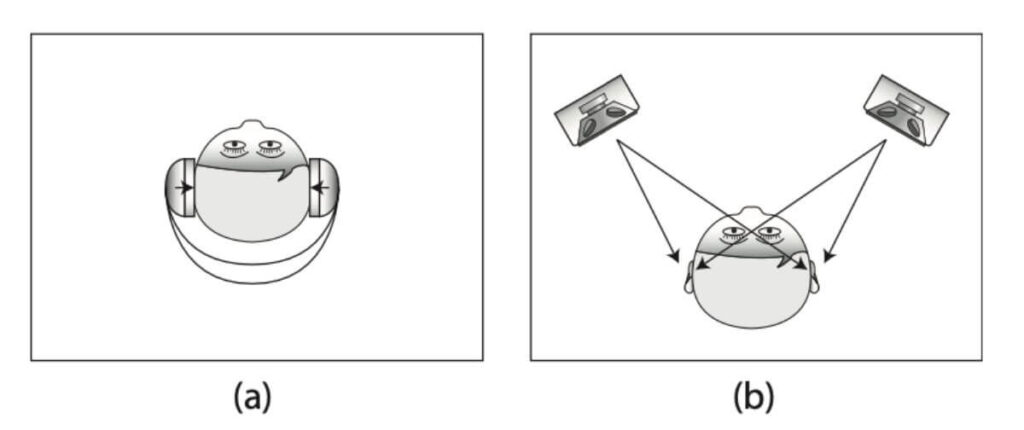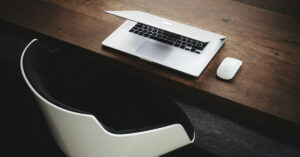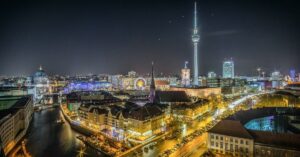Producing on headphones vs. speakers: What are the advantages? 1
In the world of music production, the debate between producing on headphones versus speakers has become more relevant than ever. With the rise of portable MP3 players, smartphones, and streaming services, more people are listening to music on headphones than ever. Despite this shift, most tracks are still mixed primarily for speaker playback, leaving producers wondering: Should we still mix for speakers when so many people are using headphones?
For electronic dance music this question is not as relevant, as the music is produced for the dancefloor and thus for big PA systems. But you might still ask yourself: Is it better to mix on studio monitors or on headphones ?
In this post, we’ll explore the technical differences, advantages, and disadvantages of both headphones and speakers to help you determine which setup is best for your production workflow and goal.
The technical differences between headphones and speakers: To understand how headphones and speakers differ, it’s crucial to recognise how each delivers sound to your ears.
- Headphones: With headphones, each ear only hears its respective channel – left for the left ear, right for the right ear. This isolation leads to precise stereo separation but can distort the spatial image.
- Speakers: In contrast, both ears hear sound from both speakers. The right ear hears the sound from the left speaker slightly later and vice versa, causing some sound blending that the brain processes as part of the stereo field.

These differences play a significant role in how sound is perceived and, therefore, how music is mixed. For example, when mixing on speakers, the Haas effect (the brain’s ability to process slight timing differences) helps create a sense of space and dimension. This blending doesn’t happen with headphones, where the sound remains completely separated, leading to a narrower soundstage.
Advantages of producing with headphones
Room Acoustics Don’t Matter
One of the biggest challenges with producing on speakers is dealing with room acoustics. Unless you’re working in a professionally treated studio, your room’s shape, materials, and furnishings all impact how sound is reflected, absorbed, or distorted. Headphones bypass this problem entirely, as they deliver sound directly to your ears without interference from the environment.
This makes headphones a great option for home studios, especially when working in smaller, untreated spaces like bedrooms. Frequencies between 80-500 Hz, often affected by room acoustics, are more accurately reproduced on headphones.
Consistency Across Listening Environments
Another key benefit of headphones is their consistency. Whether you’re in your home studio, a café, or on the go, headphones offer a reliable reference point for your mixes. Unlike speakers, which can sound drastically different depending on the room they’re in, headphones stay consistent across environments, making them a valuable tool for travelling producers.
Precision for Certain Mix Elements
While headphones have some limitations (which we’ll get to later), they excel in certain areas. Compression, gating, and dynamic range adjustments can all be handled effectively on headphones. As long as the processing doesn’t affect the perceived depth or spatial image, headphones provide a precise reference for these tasks.
Disadvantages of producing with headphones
Distorted Soundstage
Headphones have a major downside when it comes to spatial imaging. The stereo field they create can be distorted, making it difficult to judge the true placement of sounds in the mix. When working on the depth or width of a mix – such as placing instruments front and back or adjusting panning – speakers are far superior.
Headphones simply cannot replicate the natural spatial imaging that speakers provide, where the brain processes sound from multiple sources in a realistic 3D space. This makes decisions related to stereo width, reverb, and other time-based effects tricky to judge on headphones alone.
No Room Reverb
When mixing on speakers, your room’s natural reverb adds depth and dimension to the sound. In contrast, mixing on headphones is like working in an anechoic chamber – there’s no room reverb, and the sound can feel dry and lifeless. This lack of reverb can make mixes on headphones less pleasant and harder to judge, especially when adding effects like reverb or delay, which benefit from a natural room response.
Fatigue and Potential Damage
Another disadvantage of using headphones is the risk of ear fatigue. Because the sound is delivered so close to your eardrums, long sessions at high volumes can quickly lead to ear fatigue, making it harder to mix accurately over time. Moreover, at high volumes, headphones pose a greater risk of hearing damage than speakers, making it essential to take regular breaks and monitor levels carefully.
Headphone amps: The hidden factor
Just as power amps influence the performance of passive speakers, headphone amps play a significant role in determining the quality of your headphone experience. Many producers overlook this, but a poor-quality headphone amp can introduce unwanted distortion, especially at higher listening levels, and even colour the sound. This can lead to inaccurate representations of your mix.
To get the most accurate sound from your headphones, investing in a good headphone amp is crucial. Cheap amps often have issues with frequency response, which can skew your perception of a track’s balance. High-quality headphones paired with a good amp can cost as much as a solid pair of near-field studio monitors, but the investment pays off with consistent, accurate sound.
Types of headphones for music production
Not all headphones are created equal, and choosing the right type for production is key. Here’s a breakdown of the main types of headphones used for critical listening and mixing:
Closed-back headphones
Closed-back headphones are designed to provide maximum isolation between the sound inside the headphones and the external environment. This makes them ideal for recording situations where you need to minimise sound leakage, such as vocal overdubs or live recordings. However, the closed-back design often causes sound to reflect back into the ear, which can lead to comb filtering, resulting in a less accurate frequency response.
These headphones are not typically suited for long listening periods due to the pressure they exert on your head, making them less comfortable for extended mixing sessions. While they’re useful in specific scenarios like noisy environments or recording, they’re not ideal for critical mixing tasks.
Open-back headphones
Open-back headphones, on the other hand, are perfect for mixing and critical listening. The open-back design allows sound to pass freely in and out of the headphones, preventing the comb filtering found in closed-back designs. This provides a more natural sound, making them far more accurate for mixing.
Additionally, open-back headphones tend to be more comfortable for long sessions. Many high-end reference headphones are open-back because they offer a balanced frequency response and minimise fatigue. The downside is that they offer little to no isolation, so they’re not ideal in noisy environments.
Semi-open headphones
As the name suggests, semi-open headphones aim to strike a balance between the isolation of closed-back designs and the natural sound of open-back models. These are a good middle-ground for those who need moderate isolation but still want better sound quality for mixing. They’re commonly used in live sound situations where some external awareness is necessary but accuracy is still important.
Advantages of producing with speakers
Despite the convenience of headphones, speakers still hold the crown when it comes to professional mixing and production, for several reasons:
Accurate spatial imaging
One of the biggest advantages of using speakers is their ability to provide accurate spatial imaging. When mixing on speakers, especially in a well-treated room, it’s much easier to place instruments across the stereo field. You can accurately judge the width of the mix and make decisions on panning, reverb, and depth without the limitations imposed by headphones.
Better for time-based effects
Speakers are superior when it comes to adjusting time-based effects like reverb and delay. These effects rely heavily on how the sound interacts with the space in which it’s played. When using speakers, you can hear how these effects contribute to the depth and dimension of the mix, something that’s hard to replicate with headphones.
Comfortable for long listening periods
Unlike headphones, speakers don’t subject your ears to close-proximity sound, which means you can mix for longer periods without ear fatigue. This allows you to maintain a fresh perspective on your mix without the risk of overexposing your ears to potentially damaging volume levels.
Disadvantages of producing with speakers
While speakers are the gold standard for professional mixing, they aren’t without their downsides:
Room acoustics are very critical
The biggest challenge with speakers is that they are highly dependent on the room you’re working in. If your room hasn’t been acoustically treated, the sound you hear may be colored by reflections, standing waves, and other acoustic issues. This can lead to inaccurate judgments about your mix. Many producers spend significant time and money treating their rooms to avoid these problems, but for those working in untreated spaces, this remains a big hurdle.
Less portable and more expensive
Speakers are not a portable option for producers who like to work in different environments or while on the road. Additionally, quality studio monitors and the acoustic treatment required to make them sound accurate can be expensive investments, especially for producers working in home studios or project spaces.
Should you mix with headphones or speakers ?
At the end of the day, the decision between headphones and speakers comes down to your specific needs and environment.
- If you’re working in an untreated or poorly treated room, headphones might give you a more accurate representation of your mix. They’re also an excellent choice for producers who need the flexibility to work on the go, those who operate in various locations, or anyone working from home with neighbours who might complain about loud music played through speakers all night. (this might often be a critical point to think of, especially in cities like Berlin lol)
- If you’re working in a well-treated studio, speakers are the way to go, especially when you need to make precise decisions on panning, reverb, and spatial effects. They provide a more natural listening experience and allow you to craft a mix that translates well across different playback systems.
Ultimately, the best solution might be to use both. Many producers check their mixes on both speakers and headphones to ensure they sound good in multiple environments. A balanced approach can help you take advantage of the benefits of both setups, ensuring your mixes sound great no matter how they’re played back. But at the end of the day, the most important factor is mastering your equipment and becoming intimately familiar with your listening environment, whether it’s your room or headphones. This means knowing exactly how things should sound in your space. You can achieve this by referencing a wide range of music, particularly within the same genre or style you want to produce, through your setup. This will help you develop a clear understanding of how your mixes should translate across different systems.







